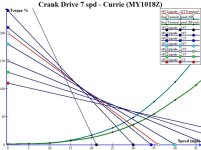dogman said:
You must be kidding!!!!
How on earth can somebody who has been on ES this long think that fed law has a thing to do with using an ebike on the public street or bike trails?
Years ago, I, upon occasion, felt it necessary to inform zealous eBike activists that H.R. 727 pertained solely to eBike manufacture.
More recently, I accidentally found
[House Report 107-5] ... "the Committee on Energy and Commerce, submitted the
following
R E P O R T
[To accompany H.R. 727]"
This report seems to justify H.R. 727 as a promotion for eBike legalization and proliferation!
Most relevant highlights
"
Purpose and Summary
... The bill removes low-
speed electric bicycles from the definition of ``motor
vehicle'' within the jurisdiction of the Department of
Transportation ... "
"
Background and Need for Legislation
Electric bicycles are in use worldwide, with the market
rapidly evolving over the last several years.
Electric bicycles
generate no pollution, are almost silent, and can greatly
increase the recreational and transportation options for
commuters.
Some electric bicycles (power-assisted) provide motorized
assistance pedaling, although they cannot be operated solely by
motor power. These bicycles, like all non-powered bicycles, are
regulated by the Consumer Product Safety Commission (CPSC).
Other electric bicycles (power-on-demand) can be operated
solely by an electric motor, but still use lightweight frames,
are used in a manner similar to non-powered bicycles. They have
maximum motorized speeds not greater than those typical of a
reasonably athletic bicyclist while biking.
Typical users of low-speed electric bicycles include
1. older and disabled riders who do not have the physical strength to
ride up hills without motorized assistance,
2. law enforcement agencies who use electric powered bicycles to increase their
patrol range, and
3. commuters who cannot afford automobile
transportation or
4. that work in traffic-congested areas.
Power-on-demand, low-speed electric bicycles are currently
regulated by the Department of Transportation by the National
Highway Traffic Safety Administration (NHTSA). Section 30111 of
title 49, U.S. Code, requires the Secretary of Transportation
to prescribe motor vehicle safety standards. The term ``motor
vehicle'' is defined by section 30102(6) as ``a vehicle driven
or drawn by mechanical power and manufactured primarily for use
on public streets, roads, and highways * * *.''
If NHTSA were to enforce its regulations on low-speed
electric bicycles strictly, the bikes would be required to have
a number of safety features, such as brake lights, turn
signals, automotive grade headlights, rear view mirrors, and
license plates, that are prohibitively costly, unwieldy, or
consume too much power for a low-speed electric bicycle. It is
estimated that the application of motor vehicle regulations to
power-assisted bicycles would increase the retail price of
these bicycles by at least $200-$300 and make them less
manageable and more unwieldy for consumers.
Since low-speed electric bicycles are designed not to
exceed the maximum speed of a human-powered bicycle, and they
are typically used in the same manner as human-powered
bicycles, electric bicycles shouldbe regulated in the same
manner and under the same agency (the CPSC) as human-powered bicycles.
Estimated impact on State, local, and tribal governments:
H.R. 727 contains an intergovernmental mandate as defined in
UMRA. The bill would expressly preempt state laws and
regulations governing low-speed electric bicycles that contain
more stringent requirements than those established by the
Consumer Product Safety Commission."
"
Section 2. Motor vehicle safety standards
Section 2 clarifies that in transferring jurisdiction over
low-speed electric bicycles to the Consumer Product Safety
Commission, those bicycles will no longer be regulated as motor
vehicles subject to the jurisdiction of the Department of
Transportation and the National Highway Traffic Safety
Administration."
This report 1st expounds the benefits of low speed electric bicycles, explains possible impediments, then promotes the removal of these impediments.
The purpose of this law, as explained, is to legalize and keep affordable, electric bicycles.
The vein of the report is that it is intended to unhinder, then promote, the legalization and proliferation of electric bicycles upon American streets!
Remember!
This report was presented with and attached to H.R. 727.
It was "in mind" and literally "in hand" as this law was passed. 



